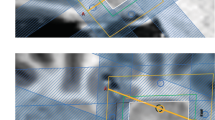Abstract
Methamphetamine (METH) is a stimulant drug that is toxic primarily to dopaminergic and serotonergic neurons and may lead to inflammatory changes in the brain. Additionally, the glutamatergic system is altered following METH exposure. Therefore, concentrations of brain glutamate + glutamine (GLX) were assessed during abstinence from chronic METH abuse. Twenty-five subjects with a history of METH dependence (age 31.8 ± 7.4 years, 14 women and 11 men) and 28 control subjects without a history of drug abuse (age 32.6 ± 8.8 years, 14 women) were enrolled. Twelve of the METH subjects were followed and rescanned 5 months later. METH users had used the drug 5.9 ± 1.7 times per week, for 109 ± 69 months, and had been abstinent for 2.1 ± 3.0 months. GLX was measured in the basal ganglia and frontal gray and white matter, using proton magnetic resonance spectroscopy. While overall GLX concentrations at baseline were similar between METH and control subjects, METH users with less than or equal to 1 month of abstinence showed reduced frontal gray matter GLX (p = 0.01). Time of abstinence correlated positively with GLX in frontal gray (p < 0.0001) and white matter (p = 0.03). After 5 months, changes in frontal gray matter GLX showed a trend to correlate inversely with the duration of abstinence (p = 0.07). Subjects with craving symptoms had lower frontal gray matter GLX than those without craving (−8%, p = 0.05). These findings suggest dynamic abnormalities in brain GLX in recently abstinent METH users, with a depletion of the glutamatergic system in METH users within the first 2 months of abstinence and some normalization during prolonged abstinence. Since craving may contribute to relapse, medications that normalize GLX may minimize craving in METH users.



Similar content being viewed by others
References
Asanuma M, Tsuji T, Miyazaki I, Miyoshi K, Ogawa N (2003) Methamphetamine-induced neurotoxicity in mouse brain is attenuated by ketoprofen, a non-steroidal anti-inflammatory drug. Neurosci Lett 352:13–16
Baker DA, McFarland K, Lake RW, Shen H, Tang X-C, Toda S, Kalivas PW (2003) Neuroadaptations in cystine–glutamate exchange underlie cocaine relapse. Nat Neurosci 6:743–749
Behar K, Rothman D, Spencer D, Petroff O (1994) Analysis of macromolecule resonances in 1H NMR spectra of human brain. Magn Reson Med 32:294–302
Bottomley PA (1987) Spatial localization in NMR spectroscopy in vivo. Ann NY Acad Sci 508:333–348
Brown JM, Yamamoto BK (2003) Effects of amphetamines on mitochondrial function: role of free radicals and oxidative stress. Pharmacol Ther 99:45–53
Chang L, Ernst T, Speck O, Grob C (2005) Additive effects of HIV and chronic methamphetamine use on brain metabolite abnormalities. Am J Psychiatr 162:361–369
Cornish J, Kalivas P (2000) Glutamate transmission in the nucleus accumbens mediates relapse in cocaine addiction. J Neurosci 20:RC 89
Ernst T, Kreis R, Ross BD (1993) Absolute quantitation of water and metabolites in the human brain. I: compartments and water. J Magn Reson B102:1–8
Ernst T, Chang L (1996) Elimination of artifacts in short echo time 1H MR spectroscopy of the frontal lobe. Magn Reson Med 36:462–468
Ernst T, Chang L, Leonido-Yee M, Speck O (2000) Evidence for long-term neurotoxicity associated with methamphetamine abuse: a 1H MRS study. Neurology 54:1344–1349
Escubedo E, Guitart L, Sureda FX, Jimenez A, Pubill D, Pallas M, Camins A, Camarasa J (1998) Microgliosis and down-regulation of adenosine transporter induced by methamphetamine in rats. Brain Res 814:120–126
Fitzmaurice PS, Tong J, Yazdanpanah M, Liu PP, Kalasinsky KS, Kish SJ (2006) Levels of 4-hydroxynonenal and malondialdehyde are increased in brain of human chronic users of methamphetamine. J Pharmacol Exp Ther 319:703–709
Hasler G, van der Veen J, Tumonis T, Meyers N, Shen J, Drevets W (2007) Reduced prefrontal glutamate/glutamine and {gamma}-aminobutyric acid levels in major depression determined using proton magnetic resonance spectroscopy. Arch Gen Psychiatry 64:193–200
Hess A, Desiderio C, McAuliffe WG (1990) Acute neuropathological changes in the caudate nucleus caused by MPTP and methamphetamine: immunohistochemical studies. J Neurocyt 19:338–342
Hurd R, Sailasuta N, Srinivasan R, Vigneron DB, Pelletier D, Nelson SJ (2004) Measurement of brain glutamate using TE-averaged PRESS at 3T. Magn Reson Med 51:435–440
Keys A, Mark G, Emre N, Meshul C (1998) Reduced glutamate immunolabeling in the nucleus accumbens following extended withdrawal from self-administered cocaine. Synapse 30:393–401
Kreis R, Ernst T, Ross BD (1993) Absolute quantitation of water and metabolites in the human brain. II: metabolite concentrations. J Magn Reson B102:9–19
London E, Simon S, Berman S, Mandelkern M, Lichtman A, Bramen J, Shinn A, Miotto K, Learn J, Dong Y, Matochik J, Kurian V, Newton T, Woods R, Rawson R, Ling W (2004) Mood disturbances and regional cerebral metabolic abnormalities in recently abstinent methamphetamine abusers. Arch Gen Psychiatry 61:73–84
Mardikian P, LaRowe S, Hedden S, Kalivas P, Malcolm R (2007) An open-label trial of N-acetylcysteine for the treatment of cocaine dependence: a pilot study. Progr Neuropsychopharmacol Biol Psychiatry 31:389–394
Morris P, Bachelard H (2003) Reflections on the application of 13C-MRS to research on brain metabolism. NMR Biomed 16:303–312
Muscoli C, Visalli V, Colica C, Nistico R, Palma E, Costa N, Rotiroti D, Nistico G, Mollace V (2005) The effect of inflammatory stimuli on NMDA-related activation of glutamine synthase in human cultured astroglial cells. Neurosci Lett 373:184–188
Nash JF, Yamamoto BK (1992) Methamphetamine neurotoxicity and striatal glutamate release: comparison to 3,4-methylenedioxymethamphetamine. Brain Res 581:237–243
Nordahl T, Salo R, Possin K, Gibson D, Flynn N, Leamon M, Galloway G, Pfefferbaum A, Spielman D, Adalsteinsson E, Sullivan E (2002) Low N-acetyl-aspartate and high choline in the anterior cingulum of recently abstinent methamphetamine-dependent subjects: a preliminary proton MRS study. Psychiatry Res 116:43–52
Nordahl TE, Salo R, Natsuaki Y, Galloway GP, Waters C, Moore CD, Kile S, Buonocore MH (2005) Methamphetamine users in sustained abstinence: a proton magnetic resonance spectroscopy study. Arch Gen Psychiatry 62:444–452
Patel A, de Graaf R, Mason G, Kanamatsu T, Rothman D, Shulman R, Behar K (2004) Glutamatergic neurotransmission and neuronal glucose oxidation are coupled during intense neuronal activation. J Cereb Blood Flow Metab 24:972–985
Pu C, Vorhees CV (1993) Developmental dissociation of methamphetamine-induced depletion of dopaminergic terminals and astrocyte reaction in rat striatum. Brain Res Dev Brain Res 72:325–328
Ramonet D, Rodriguez M, Fredriksson K, Bernal F, Mahy N (2004) In vivo neuroprotective adaptation of the glutamate/glutamine cycle to neuronal death. Hippocampus 14:586–594
Shen J, Petersen K, Behar K, Brown P, Nixon T, Mason G, Petroff O, Shulman G, Shulman R, Rothman D (1999) Determination of the rate of the glutamate/glutamine cycle in the human brain by in vivo 13C NMR. Proc Natl Acad Sci USA 96:8235–8240
Stephans S, Yamamoto B (1996) Methamphetamines pretreatment and the vulnerability of the striatum to methamphetamine neurotoxicity. Neuroscience 72:593–600
Sung Y, Cho S, Hwang J, Kim S, Kim H, Bae S, Kim N, Chang K, Daniels M, Renshaw P, Lyoo I (2007) Relationship between N-acetyl-aspartate in gray and white matter of abstinent methamphetamine abusers and their history of drug abuse: a proton magnetic resonance spectroscopy study. Drug Alcohol Depend 88:28–35
Tata DA, Yamamoto BK (2007) Interactions between methamphetamine and environmental stress: role of oxidative stress, glutamate and mitochondrial dysfunction. Addiction 102(Suppl 1):49–60
Thomas DM, Walker PD, Benjamins JA, Geddes TJ, Kuhn DM (2004) Methamphetamine neurotoxicity in dopamine nerve endings of the striatum is associated with microglial activation. J Pharmacol Exp Ther 311:1–7
Volkow N, Chang L, Wang G-J, Fowler J, Franceschi D, Sedler M, Gatley S, Miller E, Hitzemann R, Ding Y-S, Logan J (2001a) Loss of dopamine transporters in methamphetamine abusers recovers with protracted abstinence. J Neurosci 21:9414–9418
Volkow N, Chang L, Wang G, Fowler J, Ding Y, Sedler M, Logan J, Franceschi D, Gatley J, Hitzemann R, Gifford A, Wong C, Pappas N (2001b) Low level of brain dopamine d(2) receptors in methamphetamine abusers: association with metabolism in the orbitofrontal cortex. Am J Psychiatry 158:2015–2021
Volkow N, Chang L, Wang G, Fowler J, Franceschi D, Sedler M, Gatley S, Hitzemann R, Ding Y, Wong C, Logan J (2001c) Higher cortical and lower subcortical metabolism in detoxified methamphetamine abusers. Am J Psychiatry 158:383–389
Wang G, Volkow N, Chang L, Miller E, Sedler M, Hitzemann R, Zhu W, Logan J, Ma Y, Fowler J (2004) Partial recovery of brain metabolism in methamphetamine abusers after protracted abstinence. Am J Psychiatry 161:242–248
Yamamoto BK, Bankson MG (2005) Amphetamine neurotoxicity: cause and consequence of oxidative stress. Crit Rev Neurobiol 17:87–118
Zou JY, Crews FT (2005) TNF alpha potentiates glutamate neurotoxicity by inhibiting glutamate uptake in organotypic brain slice cultures: neuroprotection by NF kappa B inhibition. Brain Res 1034:11–24
Acknowledgments
This study was supported by the National Institute on Drug Abuse (NIDA, K-20 DA00280 and K-24 DA016170 for L.C. and K-02 DA16991 for T.E.) and the National Center for Research Resources (NCRR, a Clinical Research Center grant M01 000425). We also thank Dianne Osborn and Jorge Jovicich for assistance with magnetic resonance data acquisition, Nina Ames and Neha Trivedi for subject coordination, and Caroline Jiang for some of the statistical analyses. Both authors received research funding from the National Institutes of Health, and Dr. Ernst additionally received research funding from Siemens Medical Solutions; however, they did not have any other conflicts of interest relevant to this work.
Author information
Authors and Affiliations
Corresponding author
Rights and permissions
About this article
Cite this article
Ernst, T., Chang, L. Adaptation of Brain Glutamate Plus Glutamine during Abstinence from Chronic Methamphetamine Use. J Neuroimmune Pharmacol 3, 165–172 (2008). https://doi.org/10.1007/s11481-008-9108-4
Received:
Accepted:
Published:
Issue Date:
DOI: https://doi.org/10.1007/s11481-008-9108-4




